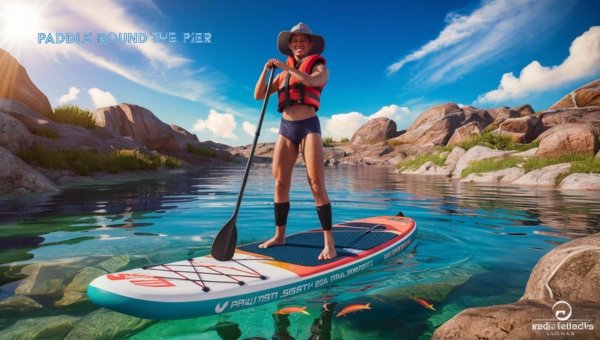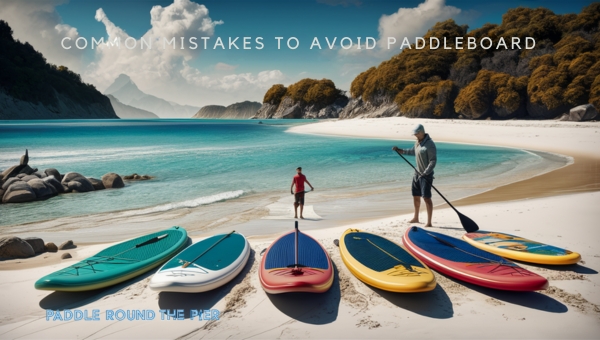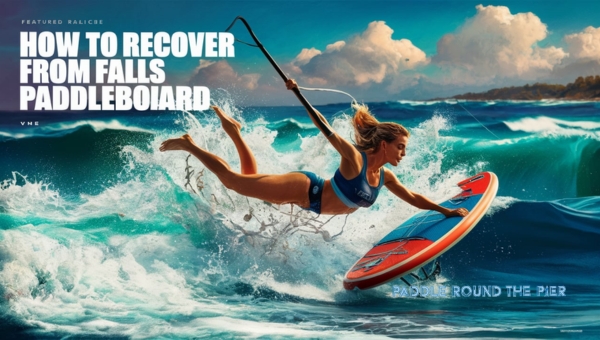How to Stand on a Paddleboard: Easy Steps for Beginners
If you're eager to learn how to stand on a paddleboard, you're in for an adventure! In this guide, we'll dive into everything from starting on your knees to mastering your balance.
You'll also discover common mistakes to avoid and how to recover gracefully from falls. By the end, you'll be confidently paddling through the waters. Ready to embark on this journey? Let's get started!
Step-by-Step Guide to Standing on a Paddleboard
Ready to master the art of standing on a paddleboard? Let's dive into the essential steps that will have you balancing like a pro in no time. From starting on your knees to transitioning smoothly to a standing position, we've got all the tips you need.

1. Starting Position
To begin, it's crucial to start on your knees. This position helps you find your balance before attempting to stand. Here's how to get started:
- Position yourself in the center of the board.
- Place your knees just behind the carry handle.
- Ensure your weight is evenly distributed.
This starting position makes the board more stable, helping you avoid tipping over as you prepare to stand.
2. Kneeling Position
When kneeling on the paddleboard, proper positioning is everything. Here's a detailed guide to get it right:
- Knees Placement: Place your knees on either side of the carry handle.
- Feet Position: Tuck your feet under your body.
- Low Center of Gravity: This setup gives you a low center of gravity, enhancing stability.
- Hand Placement: Hold the paddle with both hands on the shaft.
- Paddle for Stability: Keep the paddle blade in the water to help stabilize the board.
- Take a Few Strokes: Paddle a bit while kneeling to gain momentum and confidence.
By following these steps, you'll be well-prepared to transition to a standing position.
3. Standing Position
Transitioning from kneeling to standing can be tricky, but it's manageable with the right technique:
- Move Your Feet: Shift your feet to the spots where your knees were.
- Smooth Stand-Up: Start by raising your chest and then extend your legs.
- Knees Slightly Bent: Keep your knees slightly bent to maintain balance.
- Look Ahead: Focus on a point in the distance to help with stability.
- Immediate Paddle Use: Place your paddle in the water right after standing to help stabilize.
This approach ensures that you stand up smoothly without losing your balance.
Also Read: Top 8 Foldable Paddle Boards of 2024: Compact & Convenient
Common Mistakes to Avoid
When learning how to stand on a paddleboard, it's easy to make a few common mistakes that can throw you off balance. By being aware of these pitfalls, you can improve your technique and enjoy a smoother paddleboarding experience. Let's dive into some of these mistakes and how to avoid them.

1. Looking Down
One frequent mistake is looking down at your feet or the water. This can quickly disrupt your balance and make you feel unsteady. Here's why keeping your gaze straight ahead is crucial:
- Center of Gravity: Looking straight ahead helps maintain a stable center of gravity. When you look down, your head's weight shifts forward, affecting your balance.
- Focus and Orientation: Keeping your eyes on the horizon helps you stay oriented and focused. It prevents you from becoming dizzy or disoriented, which can happen if you fixate on the moving water beneath you.
- Confidence: Looking ahead boosts your confidence. It gives you a sense of control and calmness, which is essential for maintaining balance.
2. Holding the Paddle Incorrectly
Another common error is holding the paddle incorrectly. A proper grip is essential for effective paddling and maintaining stability. Here's how to do it right:
- Grip Height: Ensure that your top hand is holding the T-grip at the end of the paddle, while your bottom hand should be positioned about halfway down the shaft. This allows for a comfortable reach and powerful strokes.
- Blade Orientation: The paddle blade should be angled forward, with the convex side facing you. This orientation helps you scoop water efficiently and maintain balance.
- Hand Placement: Avoid gripping the paddle too tightly. A relaxed grip reduces fatigue and allows for smoother, more controlled movements.
3. Standing Too Far Back or Forward
Incorrect foot placement can significantly affect your balance and control. Here's how to position your feet correctly:
- Center Position: Place your feet around the carry handle, typically the board's center. This ensures the board remains flat and balanced on the water.
- Width: Keep your feet hip-width apart. This stance provides a stable base and helps you balance more effectively.
- Parallel Feet: Ensure your feet are parallel to each other. This alignment aids in maintaining a stable posture and allows for easier adjustments.
4. Not Engaging Your Core
Engaging your core muscles is vital for maintaining stability on a paddleboard. Here's why it's important and how to do it:
- Stability: A strong core helps stabilize your entire body. It absorbs wobbles and movements, preventing you from tipping over.
- Posture: Engaging your core keeps your posture upright and aligned. This reduces strain on your back and legs, making it easier to balance.
- Control: Core engagement provides better control over your movements. It allows you to make quick adjustments and react to changes in water conditions.
5. Adjusting for Conditions
Adapting your stance and technique according to different water conditions is essential for a successful paddleboarding experience. Here's how to adjust:
- Choppy Waters: In rough or choppy waters, widen your stance for better stability. Bend your knees slightly to absorb the waves and maintain balance.
- Calm Waters: In calm conditions, a narrower stance may be more comfortable. You can stand more upright and focus on smooth, efficient paddling.
- Windy Conditions: When it's windy, lower your center of gravity by bending your knees more. This helps you stay grounded and reduces the impact of gusts.
By avoiding these common mistakes and following these tips, you'll be well on your way to mastering how to stand on a paddleboard.
How to Recover from Falls
Falling off a paddleboard can be part of the adventure, but knowing how to recover quickly and safely is important. Let's explore some handy tips to minimize injury when falling and the steps to climb back onto your board with ease.

Tips on Falling Safely
When you find yourself about to take a tumble, there are some key practices to keep in mind to ensure you fall safely:
- Aim to Fall Away from the Board: Try to fall into the water rather than onto the board to avoid injuries from hitting the hard surface.
- Keep Your Arms Close: Protect your arms by keeping them close to your body. This reduces the risk of them getting hurt or tangled.
- Relax as You Fall: It might seem counterintuitive, but staying relaxed helps your body absorb the impact better and reduces the chance of injury.
Steps to Get Back on Your Board
Once you've fallen, getting back on your paddleboard might seem tricky, but following these steps can make it straightforward:
- Swim to the Side of the Board: Approach your paddleboard from the side rather than the front or back to prevent it from tipping over.
- Grab the Edges: Use both hands to hold onto the edges of the board for stability.
- Kick and Pull: Kick your legs in the water to create upward momentum while pulling yourself onto the board, aiming to get your hips over the centerline.
- Roll onto Your Knees: Once your hips are on the board, shift your weight and roll onto your knees to regain balance before attempting to stand again.
By following these steps and tips, you'll be back on your paddleboard in no time, ready to continue your adventure!
Also Read: Blackfin Paddle Board Review: Your Perfect Water Adventure
Maintaining Balance and Posture
Keeping your balance and posture on a paddleboard is key to enjoying your time on the water. It’s not just about standing up; it’s about staying up. Let’s explore how to keep your momentum and adjust your stance to ensure a stable and enjoyable paddleboarding experience.
Keeping Your Momentum
Maintaining momentum is vital for staying balanced on a paddleboard. Here’s how it helps:
- Consistent Movement: Continuously paddling keeps the board moving forward, which makes it easier to balance. Think of it like riding a bike – it’s easier to stay upright when you’re moving.
- Steadying Effect: The motion of paddling acts as a stabilizer. Each paddle stroke helps to correct small imbalances and keeps you steady on the board.
- Rhythmic Paddling: Establish a rhythm with your paddling. A smooth, consistent pace helps maintain momentum and keeps you balanced. Avoid sudden or jerky movements that could throw you off.
Adjusting Your Stance
Adjusting your stance based on your comfort and water conditions is crucial. Follow these tips:
- Foot Placement: Position your feet shoulder-width apart. This provides a solid base and helps with stability. Keep your knees slightly bent to absorb any waves or movements.
- Center of Gravity: Lower your center of gravity by bending your knees and keeping your body relaxed. This makes it easier to adjust to any shifts in the water.
- Wide Stance on Choppy Waters: In rougher conditions, spread your feet a bit wider. This wider stance increases your stability and makes it easier to handle waves.
- Narrow Stance on Calm Waters: When the water is calm, a narrower stance can be more comfortable and allow for smoother paddling. Adjust as needed to find what works best for you.
By keeping your momentum and adjusting your stance as needed, you’ll find it easier to maintain your balance and have a fun, enjoyable time paddleboarding. Happy paddling!
FAQs
Why can't I stand up on my paddleboard?
You might be struggling to stand up on your paddle board due to poor balance or incorrect foot placement. Make sure to start on your knees and position your feet properly to find stability.
Is it easy to learn Stand Up Paddle Boarding?
Yes, Stand Up Paddle Boarding is relatively easy to learn, especially with some practice and patience. Starting on calm water and following basic steps can help you get the hang of it quickly.
How do you not fall when paddle boarding?
To avoid falling, keep your gaze on the horizon, engage your core muscles, and maintain a slight bend in your knees. Using your paddle for stability can also help maintain balance.
Conclusion
Learning how to stand on a paddleboard can be an exciting and rewarding experience. By starting on your knees, transitioning smoothly to a standing position, and avoiding common mistakes, you can master this skill with confidence. Remember to keep your balance by engaging your core and adjusting your stance as needed. Practice these steps regularly, and soon you'll be paddling like a pro.
If you found this guide helpful, be sure to check out more of our blogs for additional tips and tricks on paddleboarding and other exciting outdoor activities!